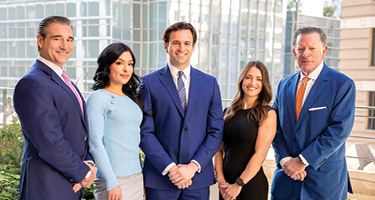Business is inherently chaotic. Ali Ghasemi seems to be among the few who appreciate the beauty of simplicity. Leaders at Mastercard, where Ghasemi has worked for nearly six years, have referred to him as a “velvet hammer,” and the sobriquet is apt: He compels change amid the most sensitive circumstances, creating satisfying outcomes for all parties. His passion for process improvement stems from his experience from industries inundated by complexity including health care and energy and his knowledge base across three degrees in law, supply chain and finance.
Currently vice president of legal services for Mastercard, Ghasemi oversees the implementation of complex new technologies to enhance the company’s legal operations at all levels; he also co-manages its panel of law firms and has taken outside counsel management from merely effective to truly world-class. Before joining Mastercard’s legal division, he led global procurement of professional services for its sourcing team. He recently sat down with Best Lawyers for a wide-ranging discussion about the role of legal operations in internal customer management, the importance of efficiency and the promise of artificial intelligence.
Talk about the outside counsel change management that enabled value-based pricing. How is this helpful for law firms, especially bigger ones with global operations?
Traditional purely hourly based approach to outside counsel fees is not only outdated, but also unsustainable. With approval from our leadership, we set out new evaluation criteria and expectations for all major law firms we work with and embedded developed corresponding in our new internal policies. We then turned to the firms to align our interests so we could implement what we regarded as a mutually beneficial approach.
For example, when we sought greater volume-based rate discounts from the firms, we anticipated pushback—so we offered them a structure in which the deeper discounts would apply only if we sustained our spend with the firm over 12 months, thus making it a rolling discount rather than a fixed, arbitrary one. This gave the firms assurance that they would not be blindly signing up for rate cuts indefinitely.
Another example was when we asked the firms about their price per deliverable or phase of work, rather than hourly pricing. We asked them to provide a fixed price or a tight pricing range for work such as patent litigation, M&A due diligence and court motions. We then pushed back on pricing and asked for greater involvement from more senior personnel for the same price. In turn, we offered them incentives for winning strategies, meeting deadlines and granted motions. In other words, using the firm’s own confidence and expertise, we offered the minimum amount of funds possible to get the work done while promising a reasonable, fixed reward for an outcome they believed they would achieve.
How did these changes affect Mastercard’s relationships with outside counsel?
Realizing that our in-house counsel maintains a professional and even social relationship with many of our panel firms, we never intended to harm that by forcing uncomfortable conversations about pricing, capabilities, diversity or other significant topics. Instead, the legal operations team stood in as an objective, logical party to negotiate with outside counsel without the direct presence of in-house counsel and thus minimizing any risk of in-house counsel losing face in a potentially adversarial negotiation.
Layering our negotiations with objective metrics such as rates and fees, expertise, diversity and ESG criteria to identify the preferred firms for each market has allowed us to provide unbiased recommendations to our counsel on firm selection for direct negotiations and RFPs which we run very frequently and rapidly.
Over your career, you’ve restructured legal and sourcing departments at BJC HealthCare and Chevron. What did those experiences teach you?
I am fortunate enough to draw my work and educational background from several countries: Canada, the U.S., Australia, South Africa, Japan, England and Angola. One of realizations has been that customers across industries and geographies all expect rapid turnaround of their needs. Purchasing and sales teams want to showcase their skills and offer a competitive advantage; other internal teams, such as legal and compliance, want as little—and as efficient—involvement as possible in contracting. Processes and technology, if left unchecked, get more complicated and spiral out of control. People rarely simplify the process, however, preferring instead to focus additional resources on solving the next problem and often adding even more complexity. This is why it’s so critical to embrace simplicity and speed.
By partnering with subject matter experts across functions to identify their requirements, you can establish a baseline of common understanding. From there, you can streamline the process to bring in only the required SMEs beyond your initial level of approval as needed, as opposed to in every instance.
To that end, how has AI improved decision making in legal operations?
Legal departments by nature are highly risk averse, so they’re often not the department leading with the newest AI innovations. There are, however, several areas of AI and process automation that have long benefited legal departments, albeit under different disguises and names, which are now receiving a facelift in accuracy and efficiency. Among these are legal research and e-discovery tools, which can rapidly scan and analyze an enormous volume of electronic documents, laws, regulations and data to identify relevant information for legal cases, reducing the time and cost of traditional document or case review without sacrificing results. Also, AI-powered contract analysis tools can augment current contract management systems to extract, categorize and review contract terms, clauses and key provisions. What’s even more interesting about these tools is that they no longer require months of “training the tool” and can produce results without precision searches—often by using natural language inquiries such as “which case or statute supports our patent litigation for financial services clients with these set of facts, in Denmark”?






















